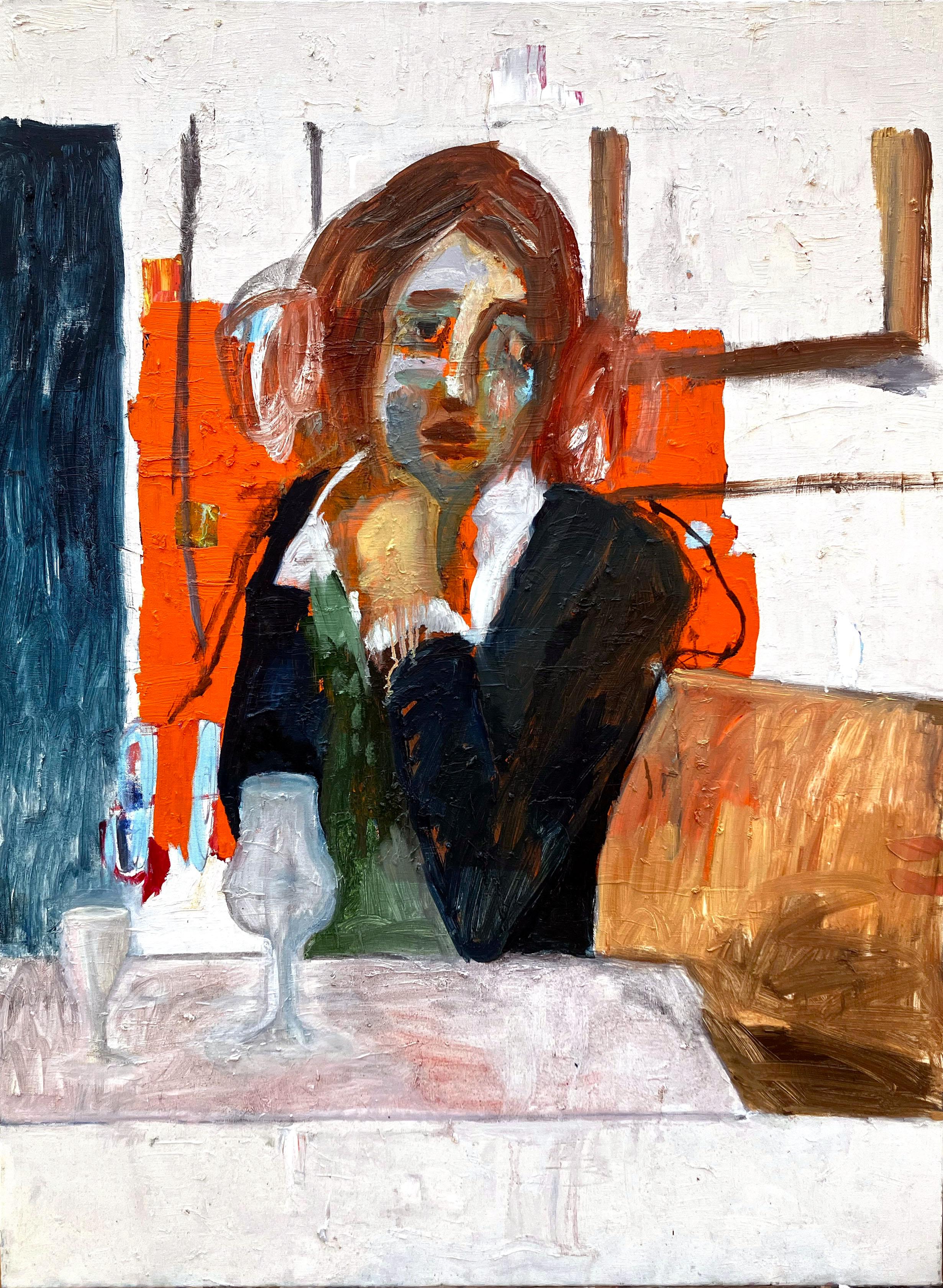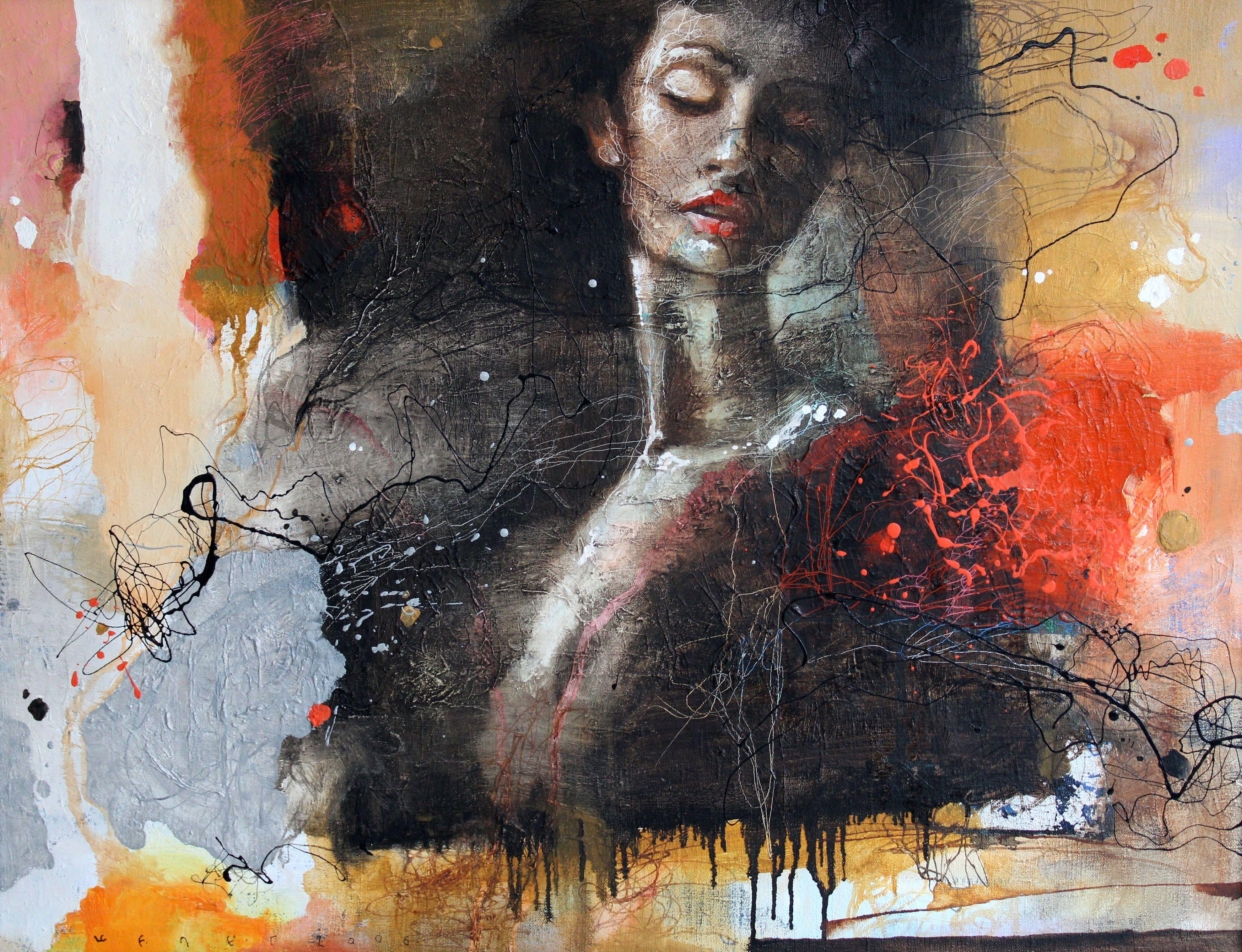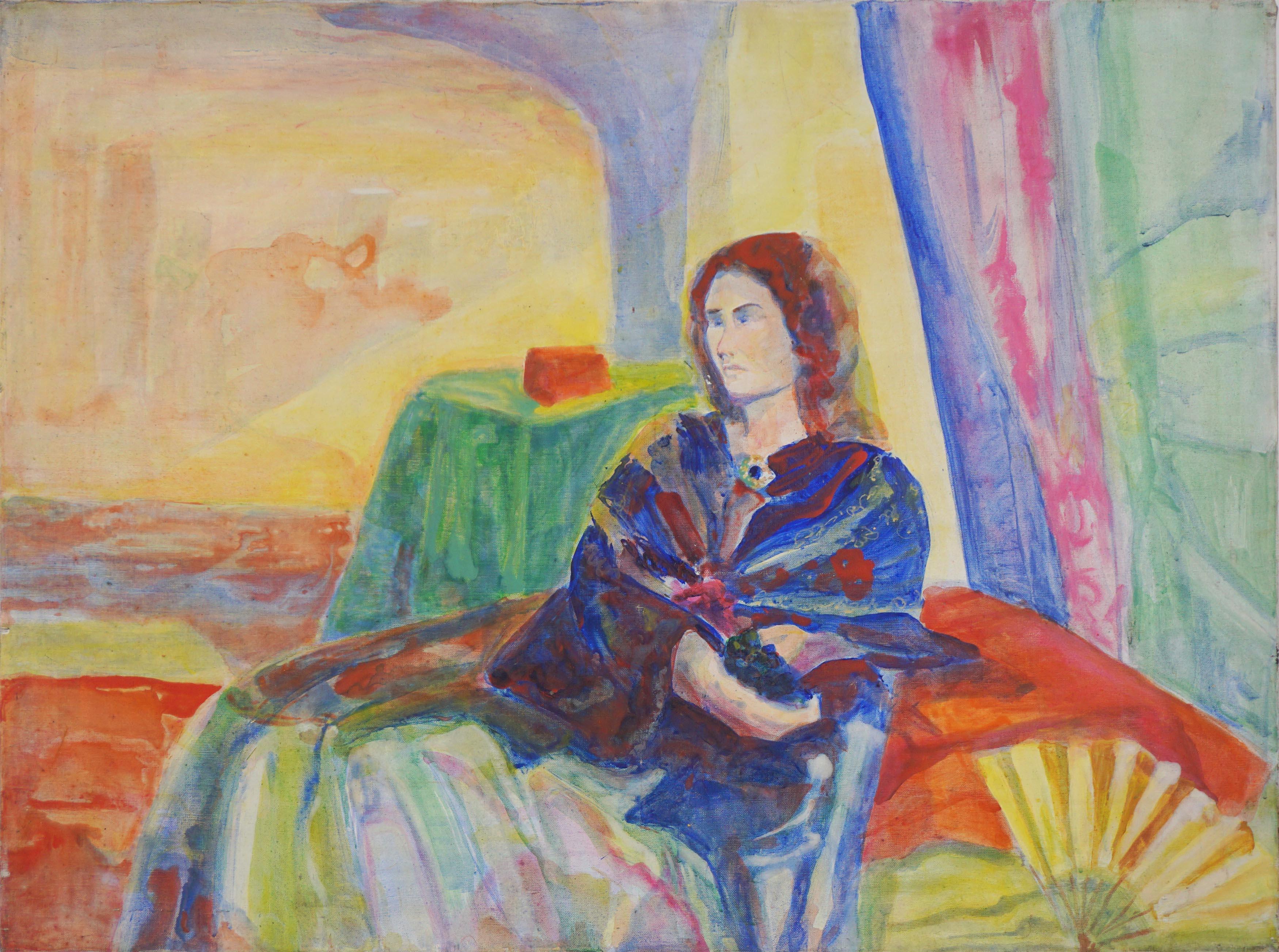Items Similar to Fine 1950's English Oil Grand Interior Room Scene Ancestral Portraits signed
Want more images or videos?
Request additional images or videos from the seller
1 of 11
English mid 20thFine 1950's English Oil Grand Interior Room Scene Ancestral Portraits signed
About the Item
The Guildhall, Worcester
English School, mid 20th century
indistinctly signed verso
oil on canvas
canvas: 20 x 24 inches
provenance: private collection, UK
condition: very good and sound condition
The Worcester Guildhall was originally built as a meeting place for Worcester merchants around 1227. As with many other guildhalls, it became the centre for civic administration, a role it maintained after the merchant guild had disappeared.
The present Worcester Guildhall is a superb Queen Anne building, begun in 1722 by Thomas White, a pupil of Sir Christopher Wren. White was badly paid for his efforts, and he died in poverty in 1738, bestowing the money he was owed on the Worcester Royal Infirmary. The city finally paid its debt in 1753.
The exterior of the Guildhall is brick, dressed with stone. White himself is said to have carved the figure of Queen Anne over the entry, as well as those of Charles I and II, a reminder of the city's long history of royal support. The interior is superb, boasting exceptional period decoration. The Tourist Information Centre is now located in the Guildhall.
HISTORY
In 1227 Henry III granted the citizens of Worcester a royal charter granting them the right to establish a guild of merchants. The guild was responsible for controlling trade in the city, but their meeting place gradually became the main centre of administration for city government and acted as a courthouse. So, in effect, the Guildhall was the town hall, and though the city guilds have long since vanished, the Guildhall name lives on.
The medieval guild merchants would not recognise the building that faces onto High Street now. Their guildhall was a large timber-framed building, occupying the same site, with a piazza for shops fronting the street, courts of justice at each end, and a prison to the north of the building.
Part of the prison was a cell called 'the peephole', which gained a notorious reputation. There was a gaoler's house, and attached to it an alehouse from which the gaoler sold ale at extremely high prices to any prisoner who could afford the cost.
In 1717 the city administration decided on a new Guildhall, and they knew just who to call; upon to build it. Thomas White was not an architect in the way we think of it today, but a stonemason. In 1705 he had carved a statue of Queen Anne to stand in front of the medieval Guildhall and was made a Freeman of the City. The total cost of the fashionable new red-brick building was £3727. The Corporation only put forward £800, and the rest had to be raised by public subscription.
The centre section of the new Guildhall was finished by 1724 and has remained almost unchanged since then. The central facade is a wonderful example of early Georgian style, with three bays flanked by Corinthian pillars.
Over the entrance is a huge carving incorporating the Hanoverian royal arms. White's earlier statue of Queen Anne was placed in a niche over the door, and on either side were statues of Charles I, depicted holding a church, and Charles II, with an orb and royal sceptre. On the rooftop are figures of Labour, Peace, Justice, Plenty, and Chastisement.
North and south wings were added within a few years of the central block. The south wing was used as a judge's lodging when the assizes were taking place, but throughout the rest of the year it housed a coffee shop.
The most striking external feature of the Guildhall is a set of iron gates and railings facing onto High Street. These were erected in 1750, and are eye-catching due to the gilded design of the entrance gateway.
The 'new' Guildhall had 3 functions; social, judicial, and civic. On the lower Hall were 2 courtrooms, and above these chambers for playing cards and taking tea. On the first floor is the Council Chamber, later called the Assembly Room. In 1788 George III and Queen Charlotte visited the Guildhall. King George drank a toast to the prosperity of the city, and called the Assembly Room a 'handsome gallery'. A portrait of the king was presented to the City after his visit and still hangs in the Assembly Room.
The exquisite chamber we see today is not the one George III saw, for it was remodelled in 1791 by George Byfield, with beautifully decorated apses at each end. Then from 1877 the architect Sir Gilbert Scott and the City Architect Henry Rowe remodelled the building and redesigned the Assembly Rooms with an extraordinary Italianate painted ceiling. The result is an opulent space, with an ornate ceiling that simply defies description.
The courtrooms on the ground floor are no longer used for judicial proceedings but are used as a mayor's parlour and a committee room.
Parts of the building are used by the civic administration, but visitors can normally visit the ground floor hall and one courtroom, then climb to the second floor to see the remarkable Assembly Room.
- Creator:English mid 20th (English)
- Dimensions:Height: 20 in (50.8 cm)Width: 24 in (60.96 cm)
- Medium:
- Movement & Style:
- Period:
- Condition:
- Gallery Location:Cirencester, GB
- Reference Number:1stDibs: LU509312760962

About the Seller
5.0
Platinum Seller
These expertly vetted sellers are 1stDibs' most experienced sellers and are rated highest by our customers.
Established in 1989
1stDibs seller since 2016
3,552 sales on 1stDibs
Typical response time: 2 hours
- ShippingRetrieving quote...Ships From: Cirencester, United Kingdom
- Return PolicyA return for this item may be initiated within 3 days of delivery.
More From This SellerView All
- French North African Orientalist Oil Painting Hareem Interior Two LadiesLocated in Cirencester, GloucestershireThe Hareem Interior French Orientalist School, late 20th century (painted after an earlier style) oil on canvas, framed framed: 30 x 34 inches canvas: 20 x 24 inches provenance: priv...Category
20th Century Modern Figurative Paintings
MaterialsCanvas, Oil
- Large French/ Polish Modernist Oil Painting Interior Room Figures Reading & DogLocated in Cirencester, GloucestershireInterior Scene by Jacob Markiel (Polish 1911-2008) *See notes below oil on canvas, unframed canvas: 34 x 30 inches provenance: the artists estate, south ...Category
Mid-20th Century Modern Figurative Paintings
MaterialsCanvas, Oil
- Mid 20th Century French Modernist Signed Oil Painting Lady Reclining on SofaLocated in Cirencester, GloucestershireThe Reclining Model French School, mid 20th century signed Labat oil on canvas, unframed board: 18 x 24 inches provenance: private collection, France condition: very good and sound c...Category
Mid-20th Century Modern Figurative Paintings
MaterialsCanvas, Oil
- Large 1970's French Modernist Oil Painting The Card Game Players Casino InteriorLocated in Cirencester, GloucestershireThe Card Game in the Casino French Modernist, circa 1970's oil on canvas, unframed canvas: 21.5 x 25.5 inches provenance: private collection, France condition: very good and sound co...Category
Mid-20th Century Modern Figurative Paintings
MaterialsOil, Canvas
- 20th Century German Modernist Oil Painting Pianist in Concert Hall with AudienceLocated in Cirencester, GloucestershireArtist: Elisabeth Hahn (German 1924-2021) Elisabeth Hahn was born in Dortmund, Germany, where she began her artistic studies. In 1953, she moved to Paris. She continued her studies ...Category
20th Century Modern Figurative Paintings
MaterialsOil, Canvas
- Very Large French Original Oil Portrait of Elegant Lady in Interior Room SettingLocated in Cirencester, GloucestershirePortrait of a Lady French School, 20th century oil painting on canvas, unframed 40 x 29 inches condition: very good and presentable provenance: private collection, Provence Superb ...Category
20th Century Impressionist Figurative Paintings
MaterialsCanvas, Oil
You May Also Like
- 1975 Vintage Mid-Century Figurative Interior Scene Oil Painting - Family HomeLocated in Bristol, GBFAMILY HOME Size: 50 x 68 cm (including frame) Oil on Canvas A wonderfully detailed modernist composition of an interior, painted in oil onto canvas and dated 1975. This charming n...Category
Mid-20th Century Modern Interior Paintings
MaterialsCanvas, Oil
- Do You Mind If I Hum While You Talk, abstracted woman in bar w brushworkBy C. DimitriLocated in Brooklyn, NYFin de Siecle, Nabis-styled woman in cafe. Abstract Expressionism looms behind her. Tribute to the fearless and incandescent painting of Édouard Vuillard.Category
2010s Modern Interior Paintings
MaterialsCanvas, Oil
- "Madam Suburbia #2" (Woman and Child, Sue & Casey) in Oil on CanvasBy Patricia Gren HayesLocated in Soquel, CA"Madam Suburbia #2" (Woman and Child, Sue & Casey) in Oil on Canvas An auburn-haired woman sits in a chair with her young child, by American painter, Patricia Gren Hayes (b. 1932). ...Category
Mid-20th Century American Modern Figurative Paintings
MaterialsCanvas, Oil
- Sublimation or weightlessness. 2006, canvas, oil, 70x90 cmBy Victor ShelegLocated in Riga, LVSublimation or weightlessness. 2006, canvas, oil, 70x90 cmCategory
Early 2000s Modern Figurative Paintings
MaterialsOil, Canvas
- William Fisher Classic American Illustration on CanvasLocated in Larchmont, NYWilliam Fisher (American, 1891-1985) Untitled, 20th Century Oil on canvas/illustration 23 3/4 x 29 3/4 in. Framed: 31 x 37 1/4 x 1 in. Signed lower right: William Fisher William Fis...Category
20th Century American Modern Figurative Paintings
MaterialsCanvas, Oil
- Modern Figurative -- Hayley in the SunroomBy Patricia Gren HayesLocated in Soquel, CAModern interior/figurative painting of red-haired woman "Hayley" seated in sunroom by American painter, Patricia Gren Hayes (b. 1932), Circa 1975. Signed on verso, "Hayley" written on edge Provenance: Purchased as part of larger collection of artist's work Unframed. Canvas size: 30"H x 440"W. Patricia Gren Hayes (American, b. 1932) is a Bay Area Figurative & Feminist Art Movement artist who studied at Winnipeg Public Art School in 1950. She received early recognition in Museum and Gallery competitions and exhibitions and was awarded a Special Education in Art recognition by the Winnipeg Museum of Fine Art, and was awarded a scholarship to the Banff College of Fine Art. Further studies were at The University of Manitoba. She was a Member of Winnipeg Free Press Sketch Club and was a Cartoonist and paste-up for a French-English bi-weekly, in Eastern Canada; She studied outdoor impressionism in New York in 1960; in 1962, attended The California College of Arts and Crafts, and in 1976 B.A., U.C. Berkeley where she studied under Elmer Bischoff, David Simpson, Joan Brown, Felix Ruvolo, Yolanda Lopez and Vincent Perez. She started a freelance commercial art business in 1963; copyrighted a National Cartoon, 1976, and served as Exhibition Director for San Francisco Woman Artists Gallery and the San Francisco Museum of Modern Art, 1976-1978. She was a workshop instructor at the San Francisco Woman Artists Gallery, 1977-1985; and was Manager/Owner Stanton Art Gallery, Alameda, CA, 1976-1982. Solo Exhibitions: Berkeley Marina, 1974; Oakland Center for The Visual Arts, "Images of Women", 1979 Group Exhibitions: Oakland's Dept of Education, 1963, Studio One; Alameda County Fair, 1975, 1976, 1978; San Francisco Art Festival, 1969, 1970, 1976, 1977, 1978; San Francisco Museum of Modern Art, 1976, 1977, 1978; San Francisco Women Artists Gallery Exhibition, award winner - 1970, 1977, 1978; Hayward Bay Fair Art Festival, award winner - 1971; Capricorn Assunder Gallery, 1973; Oakland Art Festival, 1973, 1974; Alameda Art Association, 1978; El Cerrito...Category
1970s American Modern Figurative Paintings
MaterialsOil, Canvas
Recently Viewed
View AllMore Ways To Browse
Mid Century Mid
Art By Mid
Interior Vintage
The Vintage Interiors
Interior Design Styles
Mid Century Interior Design
Interior Design Vintage Modern
Modern Vintage Interior Design
Modern And Vintage Interior Design
Vintage Style Interior
Retro Mid Century Interior Design
Mid Century Modern Vintage Interior Design
Mid Century Fine Art
Mid Century Entry Set
Red Mid Century Art
Interior Rooms
English House
Play Room Art





